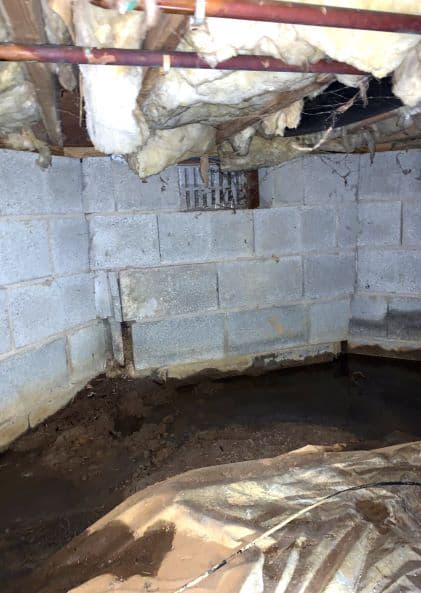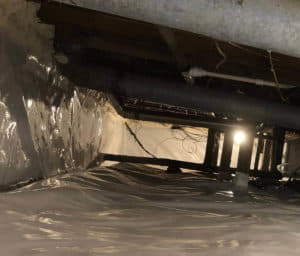Air Quality in Your Crawl Space: What Are You Breathing?

Originally posted 3/19/20. Updated 8/6/21
Increasingly, people are concerned about the indoor air quality of their homes. This is not a surprising development. Our society in general has been becoming more aware of (and worried about) our air quality. Much of this interest began when so many of us began working from home, or were required to stay home during the COVID-19 lockdowns.
But some of it also stems from our awareness of the growing number of pollutants in our environment. Many countries are taking steps to limit greenhouse gas emissions, and companies are working to adopt more “green” practices- but this is a bit like closing the barn door after the horse escapes.
Acculevel has been waterproofing and encapsulating crawl spaces since our start in 1996. We have recently seen an increase in customers’ concerns about the air quality in their homes. After reviewing the most commonly asked questions, we’ve decided to address them in this article to improve everyone’s understanding.
How Does Air Quality Affect Your Health?
Much of the recent interest in air quality can be traced back to the development of new virus strains, and our desire to avoid contracting them. In the last ten years or so, we’ve had a number of major global outbreaks: Swine Flu (H1N1), (Avian) Influenza, Middle East respiratory syndrome coronavirus (MERS-CoV), Zika, and COVID-19.
We need to defend ourselves from more than just epidemics and pandemics. The last regular flu season in Winter 2018-2019 infected over 35 million Americans, and caused 490,600 hospitalizations and 34,200 deaths. Children and the elderly are the most vulnerable, as is anyone with a compromised immune system.
Air quality is obviously important to everyone (we all need oxygen!), but as individuals we have little control over the contents of our atmosphere. However, your home’s environment is something you can improve. Beyond that, it’s essential to focus on indoor air quality for anyone who has allergies, asthma, a compromised immune system, respiratory issues, or may become home-bound.
 This image of the identified H1N1 influenza virus was taken in the CDC Influenza Laboratory.
This image of the identified H1N1 influenza virus was taken in the CDC Influenza Laboratory.
What is Wrong With the Air Quality in Your Home?
The most common issue is that the air in your crawl space is full of unseen pollutants, and those pollutants don’t stay in the crawl space. Let’s break down the primary issues:
- Moisture. Damp air feeds mold and mildew, which love to grow in dark and humid places. As mold grows, it releases spores into the air. These spores are a major allergen, and breathing in mold spores has been linked to an increased risk of developing asthma.
- Vapors. Very few crawl spaces have a true floor. Most crawl spaces have dirt “floors,” that allow water vapor, odors, and gases like radon to move from the ground into your home. If your home has a vapor barrier installed, this can help mitigate this. A vapor barrier is a thin piece of plastic that covers the dirt, but is not sealed at the joints, edges or around any columns or plumbing. It is typically just loosely laid on the ground, to act as a physical block.
- Wind currents. Your foundation is not airtight; homes generally have vents installed to allow fresh air. But this means the wind blows pollen, dust and other particles from the outside into your home. Your HVAC filter may help with reducing these particles- but only when it’s actively running. The rest of the time, these allergens are freely circulating in your home.
- Stack effect. This is also sometimes called the chimney effect. It’s a term that describes the air movement in your home. As we learned in science class, warm air rises and cool air sinks. The stack effect is the process of cold air pushing the heat up and out of your home (in the winter). It has less effect on your home in the summer, but it does still exist. For our purposes here, the important thing to remember is that the air in your crawl space gets drawn into and through your home.
- HVAC. It’s an obvious fact that your heating and air conditioning systems regulate the temperature in your home. What many of us overlook is how the HVAC accomplishes this. It heats or cools the air and disperses it through your home. It’s not sterilizing the air as it does this; it’s only filtering it. And it’s only filtering when the heat or A/C is actively running.
 This photo was taken by an Acculevel project advisor during a routine free estimate. This is a crawl space needing repair- old insulation is saturated and falling, the vapor barrier is insufficient, and standing water is visible around the edges.
This photo was taken by an Acculevel project advisor during a routine free estimate. This is a crawl space needing repair- old insulation is saturated and falling, the vapor barrier is insufficient, and standing water is visible around the edges.
How Can You Improve Your Home’s Indoor Air Quality?
We recommend that you encapsulate your crawl space, because this will give you the most relief from pollutants, significantly improve air quality, and decontaminate your environment. Encapsulation will address all of the issues we’ve discussed, and provide you with a clean, nearly-sterile environment under your home. Many customers use their now-encapsulated crawl spaces as storage for holiday decorations, out-of-season clothing, and the like.
- Water drainage. If you have a wet crawl space, you need to address that water and get it out of your home in an efficient manner. Waterproofing will collect the moisture, drain it to a sump pump, then expel it from your home. As an additional benefit, this gets the water away from your foundation where it can cause a variety of damages.
- Dehumidifier. You have the water contained and controlled, now take the humidity out of the air. A dehumidifier is an essential part of the encapsulation process, and can significantly improve your air quality. Research has demonstrated that dehumidifiers can effectively remove viruses from the air.
 There is a decisive point at the 50% humidity level. This is the ideal humidity level to reduce or eliminate bacteria, viruses, fungi, mites, and allergens- reducing your chances of a respiratory infection.
There is a decisive point at the 50% humidity level. This is the ideal humidity level to reduce or eliminate bacteria, viruses, fungi, mites, and allergens- reducing your chances of a respiratory infection. - Mold treatment (if needed). If you have mold growing on any of your structural wood framing, you need to address that promptly. If you know anything about allergies, you don’t need me to explain the dangers of mold to you.
- Encapsulate. This is accomplished by putting down a heavy plastic barrier (usually about triple the thickness of a vapor barrier), then attaching it to the walls and sealing around all columns, plumbing, and joints. This will block the gases escaping from the earth, as well as keep out pollen or pollutants coming in at the foundation level.
- Stack Effect? Encapsulation will not eliminate the stack effect, but it will reduce it to strictly a temperature problem. This is because the vents in your foundation are also sealed off; this makes your crawl space a conditioned area like the rest of your home.
- Upgrade and change HVAC filters regularly. The EPA recommends the report produced by the American Society of Heating, Refrigerating and Air-Conditioning Engineers (ASHRAE) Journal. The takeaway of this in-depth analysis: “a good choice for a central HVAC system filter is one rated at a minimum efficiency reporting value (MERV) of 13 or higher.”
 This photo was taken by an Acculevel crew member, after completing encapsulation.
This photo was taken by an Acculevel crew member, after completing encapsulation.
Are You Ready for Encapsulation?
If you need more information about crawl space repairs and costs, we have more to share! You can read our other blogs on this topic, which investigate the risks of mold, the costs to repair water damage to foundations, or the costs associated with encapsulation.
If your answer is yes, find an experienced company, and make an appointment. Before you sign a contract for any service, always verify the company is reputable, insured, and accredited by the Better Business Bureau.
If you live in Indiana or the surrounding states, contact Acculevel. If you have noticed any problems and would like an evaluation, you can request a free estimate. An experienced project advisor will examine the areas of concern and recommend the best course of action for you, to keep you AND your home strong and healthy for years to come.
 There is a decisive point at the 50% humidity level. This is the ideal humidity level to reduce or eliminate bacteria, viruses, fungi, mites, and allergens- reducing your chances of a respiratory infection.
There is a decisive point at the 50% humidity level. This is the ideal humidity level to reduce or eliminate bacteria, viruses, fungi, mites, and allergens- reducing your chances of a respiratory infection.